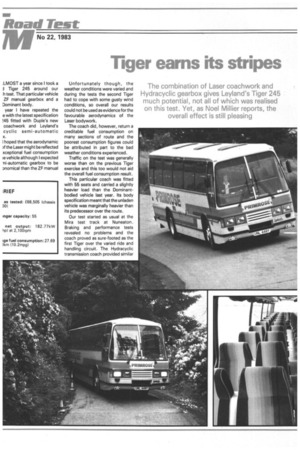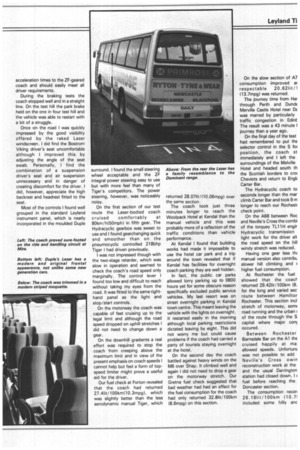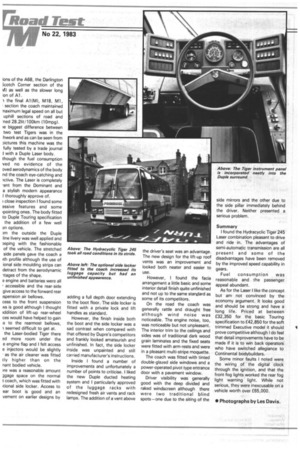Tiger earns its stripes
Page 52

Page 53

Page 54

If you've noticed an error in this article please click here to report it so we can fix it.
,LMOST a year since I took a I Tiger 245 around our h test. That particular vehicle ZF manual gearbox and a Dominant body.
year I have repeated the e with the latest specification !45 fitted with Duple's new coachwork arid Leyland's cyclic semi-automatic x.
I hoped that the aerodynamic if the Laser might be reflected xceptional fuel consumption ie vehicle although I expected • ni-automatic gearbox to be Dnornical than the ZF manual Unfortunately though, the weather conditions were varied and during the tests the second Tiger had to cope with some gusty wind conditions, so overall our results could not be used as evidence for the favourable aerodynamics of the Laser bodywork.
The coach did, however, return a creditable fuel consumption on many sections of route and the poorest consumption figures could be attributed in part to the bad weather conditions experienced.
Traffic on the test was generally worse than on the previous Tiger exercise and this too would not aid the overall fuel consumption result.
This particular coach was fitted with 55 seats and carried a slightly heavier load than the Dominantbodied vehicle last year. Its body specification meant that the unladen vehicle was marginally heavier than its predecessor over the route.
Our test started as usual at the Mira test track at Nuneaton. Braking and performance tests revealed no problems and the coach proved as sure-footed as the first Tiger over the varied ride and handling circuit. The Ilydracyclic transmission coach provided similar
acceleration times to the ZF-geared coach and should easily meet all driver requirements.
During the braking tests the coach stopped well and in a straight line. On the test hill the park brake held on the one in four test hill and the vehicle was able to restart with a bit of a struggle.
Once on the road I was quickly impressed by the good visibility offered by the raked Laser windscreen. I did find the Bostrom Viking driver's seat uncomfortable although I improved this by adjusting the angle of the seat swab. Personally, I find the combination of a suspension driver's seat and air suspension unnecessary and in danger of creating discomfort for the driver. I did, however, appreciate the high backrest and headrest fitted to the seat.
Most of the controls I found well grouped in the standard Leyland instrument panel, which is neatly incorporated in the moulded Duple surround. I found the small steering wheel acceptable and the ZF integral power steering easy to use but with more feel than many of Tiger's competitors. The power steering, however, was noticeably noisy.
On the first section of our test route the Laser-bodied coach cruised comfortably at 80krn/h(50mph) in fifth gear. The Hydracyclic gearbox was sweet to use and I found gearchanging quick and smoother than on the pneumocyclic controlled 218bhp Tiger I had driven previously.
was not impressed though with the two-stage retarder, which was slow in operation and seemed to check the coach's road speed only marginally. The control lever I found too low and difficult to reach without taking my eyes from the road. It was fitted to the same righthand panel as the light and stop/start controls.
On the motorway the coach was capable of fast cruising up to the legal limit and although the road speed dropped on uphill stretches I did not need to change down a gear.
On the downhill gradients a real effort was required to stop the coach from creeping above the maximum limit and in view of the present emphasis on coach speeds I cannot help but feel a form of topspeed limiter might prove a useful aid for the driver.
Our fuel check at Forton revealed that the coach had returned 27.41it/100km(10.3mpg), which was slightly better than the less aerodynamic manual Tiger, which returned 28.0714/(10.06mpg) over the same section.
The coach took just three minutes longer to reach the Woolpack Hotel at Kendal than the manual vehicle and this was probably more of a reflection of the traffic conditions than vehicle performance.
At Kendal I found that building works had made it impossible to use the hotel car park and a trip around the town revealed that if Kendal has facilities for overnight coach parking they are well hidden.
In fact, the public car parks allowed lorry parking up to 0800 hours yet for some obscure reason specifically excluded public service vehicles. My last resort was on street overnight parking in Kendal town centre. This meant leaving the vehicle with the lights on overnight. It restarted easily in the morning although local parking restrictions dictated leaving by eight. This did not worry me but could cause problems if the coach had carried a party of tourists staying overnight at the hotel.
On the second day the coach battled against heavy winds on the M6 over Shap. It climbed well and again I did not need to drop a gear on the motorway stretch. Our Gretna fuel check suggested that bad weather had had an effect for the fuel consumption for the coach had only returned 32.81it/100km (8.6mpg) on this section. On the slow section of A7 consumption improved ar respectable 20 .621it /1 (13.7mpg) was returned.
The journey time from Har through Perth and DundE Merville Castle Hotel near DC was marred by particularly traffic congestion in Edint The result was a 43 minute I journey than a year ago.
On the final day of the test had remembered to put thE selector control in the S for position, the coach St immediately and 1 left the surroundings of the Melville Hotel and headed south th the Scottish borders to cro; Cheviots and return to Engli Carter Bar.
The Hydracyclic coach to seconds longer than the mar climb Carter Bar and took 9 m longer to reach our Rochesti check point.
On the A68 between Roc and Neville's Cross the combi of the torquey TL11H engir Hydracyclic transmission light work for the driver alt the road speed on the hill windy stretch was reduced.
Having one gear less th4 manual version also contribL slower hill climbing and higher fuel consumption.
At Rochester the fuel showed that the coachreturned 29.421it/100km 19. for the long and varied sec. route between Hamiltor Rochester. This section incl stretch of motorway, sorm road running and the urban ; of the route through the S capital where major cons occu red.
Between Rochester Barnsdale Bar on the Al the cruised happily at ma: allowed speeds. UnfortunE was not possible to add Neville's Cross owin reconstruction work at the and the usual Darrington station had closed down. I r fuel before reaching the Doncaster section.
The consumption recon 26.181it/100km (10.7! included some hilly anc ions of the A68, the Darlington icotch Corner section of the V1) as well as the slower long in of Al.
-1 the final Al (M), M18, Ml, section the coach maintained naximum legal speed on all but uphill sections of road and .ned 28.21it/100km (10mog). le biggest difference between two test Tigers was in the hwork and as can be seen from 3ictures this machine was the fully tested by a trade journal with a Duple Laser body. though the fuel consumption ved no evidence of the oved aerodynamics of the body nd the coach eye-catching and Ictive. The Laser is completely -ent from the Dominant and a stylish modern appearance I thoroughly approve of.
close inspection I found some essive features and some 'pointing ones. The body fitted to Duple Touring specification the addition of a few well e.n options.
)rn the outside the Duple line livery was well applied and eeping with the fashionable of the vehicle. The stretched side panels gave the coach a ith profile although the use of ional side moulding strips can detract from the aerodynamic ltages of the shape.
e engine and batteries were all accessible and the rear-side give access to the forward rear ispension air bellows.
Gess to the front suspension /vs is good although I thought iddition of lift-up rear-wheel ces would have helped to gain s to the rearmost bellows, .1 seemed difficult to get at. the Laser-bodied Tiger there ed more room under the e engine flap and I felt access e injectors would be slightly as the air cleaner was fitted tly higher than on the nant bodied vehicle.
?re was a reasonable amount ggage space on the normal t coach, which was fitted with itional side locker. Access to ear boot is good and an vement on earlier designs by adding a full depth door extending to the boot floor. The side locker is fitted with a private lock and lift handles as standard.
However, the finish inside both the boot and the side locker was a sad contrast when compared with that offered by Dupre's competitors and frankly looked amateurish and unfinished. In fact, the side locker inside was unpainted and still carried manufacturer's instructions.
Inside I found a number of improvements and unfortunately a number of points to criticise. I liked the new Duple ducted heating system and I particularly approved of the luggage racks with redesigned fresh air vents and rack lamps. The addition of a vent above the driver's seat was an advantage. The new design for the lift-up roof vents was an improvement and looked both neater and easier to use.
However, I found the facia arrangement a little basic and some interior detail finish quite unfinished and not up to the same standard as some of its competitors.
On the road the coach was generally rattle and draught free although wind noise was noticeable. The engine noise, too, was noticeable but not unpleasant. The interior trim to the ceilings and sides was of traditional dark wood grain laminates and the fixed seats were fitted with arm-rests and were in a pleasant multi-stripe moquette.
The coach was fitted with tinted double-glazed side windows and a power-operated pivot type entrance door with a pavement window.
Driver visibility was generally good with the deep divided and raked windscreen although there were two traditional blind spots—one due to the siting of the side mirrors and the other due to the side pillar immediately behind the driver. Neither presented a serious problem.
Summary I found the Hydracyclic Tiger 245 Laser combination pleasant to drive and ride in. The advantages of semi-automatic transmission are all present and some of the disadvantages have been removed by the improved speed capability in gears.
Fuel consumption was reasonable and the passenger appeal abundant.
As for the Laser I like the concept but am not convinced by the economy argument. It looks good and should be strong and have a long life. Priced at between £32,350 for the basic Touring specification to £42,850 for the soft trimmed Executive model it should prove competitive although I do feel that detail improvements have to be made if it is to win back operators who have switched allegiance to Continental bodybuilders.
Some minor faults I noted were the wiring of the digital clock through the ignition, and that the front fog lights worked the rear fog light warning light. While not serious, they were inexcusable on a vehicle worth over £65,000.
































































































